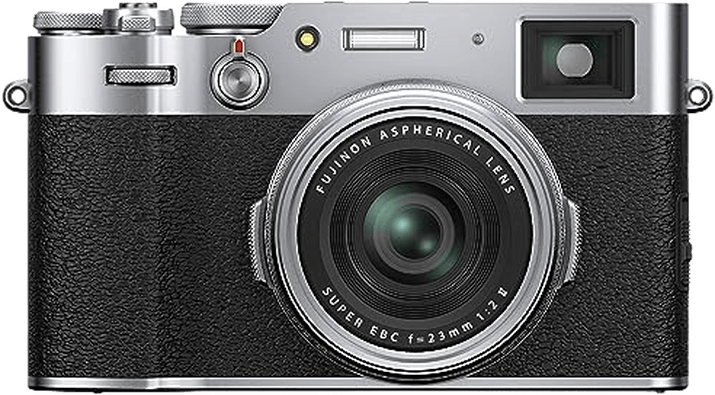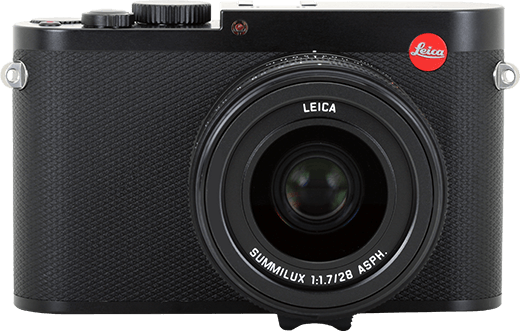Fujifilm X100V vs Leica Q Typ 116 Comparison
Fujifilm X100V

Leica Q Typ 116

The Fujifilm X100V emerges as the winner with a score of 69/100, while the Leica Q Typ 116 scores 64/100. Both cameras share similar features, including mirrorless and compact designs. The X100V, released in 2020, has a more competitive price at $1399 compared to the Typ 116’s $4250 launch price in 2015.
The Fujifilm X100V is lighter, weighing 478g, and has a smaller size of 128 x 75 x 53mm. This makes it more portable and convenient for users. On the other hand, the Leica Q Typ 116 weighs 640g and measures 130 x 80 x 93mm, making it slightly bulkier.
Taking these factors into account, the Fujifilm X100V offers a better balance of price, weight, and size, while the Leica Q Typ 116 may appeal to those who prefer a more substantial camera.
Fujifilm X100V vs Leica Q Typ 116 Overview and Optics
The Leica Q Typ 116 wins in the optics comparison with a score of 72/100, while the Fujifilm X100V scores 66/100. Both cameras share common specifications, including a CMOS sensor, no image stabilization, and a fixed lens mount, meaning the lenses cannot be changed.
The Leica Q Typ 116 has a superior sensor size, being a full-frame camera, compared to the Fujifilm X100V’s APS-C sensor. This larger sensor contributes to better image quality in various lighting conditions. Additionally, the Leica Q Typ 116 has a DXOMARK score of 85 for its sensor, whereas the Fujifilm X100V does not have a DXOMARK score. The Leica Q Typ 116 also uses the Maestro II processor, which provides efficient performance and image processing.
On the other hand, the Fujifilm X100V has a higher megapixel count of 26, compared to the Leica Q Typ 116’s 24.2 megapixels. This results in slightly higher resolution images, which can be advantageous for cropping or large prints. The Fujifilm X100V also has a faster shooting speed of 11 frames per second, compared to the Leica Q Typ 116’s 10 frames per second, allowing for better capture of fast-moving subjects.
Considering these points, the Leica Q Typ 116 is the better camera in terms of optics, mainly due to its full-frame sensor and higher DXOMARK score. The Fujifilm X100V, however, offers a higher resolution and faster shooting speed. Ultimately, the choice between these two cameras depends on the user’s priorities and preferences, as both cameras have their strengths and weaknesses in the optics department.
Fujifilm X100V vs Leica Q Typ 116 Video Performance
The Fujifilm X100V outperforms the Leica Q Typ 116 in video capabilities, scoring 91/100 compared to the Leica’s 70/100. Both cameras share certain features, such as time-lapse functionality built in. However, the Fujifilm X100V surpasses the Leica Q Typ 116 in several aspects, making it the superior choice for video recording.
The Fujifilm X100V has a maximum video resolution of 4K (4096 x 2160) while the Leica Q Typ 116 only reaches Full HD (1920 x 1080). This difference in resolution provides the Fujifilm X100V with a significant advantage, as it captures more detail and offers higher quality footage. Furthermore, the Fujifilm X100V supports a max video frame rate of 120fps, double the Leica Q Typ 116’s 60fps. This higher frame rate allows for smoother video playback and the option to create slow-motion footage.
Although the Leica Q Typ 116 has a lower score, it still provides adequate video quality for casual users and shares the time-lapse functionality with the Fujifilm X100V. However, it falls short in the areas of resolution and frame rate, which are essential for professional videographers or those seeking high-quality footage.
The Fujifilm X100V’s superior video capabilities make it the clear winner in this comparison. With its 4K resolution and 120fps frame rate, it caters to professionals and enthusiasts alike. The Leica Q Typ 116 remains a viable option for casual users but lacks the advanced features found in the Fujifilm X100V. Ultimately, those seeking top-notch video performance should opt for the Fujifilm X100V, while the Leica Q Typ 116 may suffice for users with more modest video requirements.
Fujifilm X100V vs Leica Q Typ 116 Features and Benefits
The Fujifilm X100V outperforms the Leica Q Typ 116 in features, scoring 85/100 compared to Leica’s 57/100. Both cameras share a 3-inch screen size, touchscreen capabilities, and lack of GPS. However, the X100V surpasses the Q Typ 116 in several aspects, while the latter has limited advantages.
The X100V excels with its screen resolution of 1,620,000 dots, significantly higher than the Q Typ 116’s 1,040,000 dots. This provides a sharper and clearer display for users. Additionally, the X100V has a flip screen, offering more flexibility for various shooting angles. In terms of connectivity, the X100V has both Wi-Fi and Bluetooth capabilities, making image transfer and remote control easier.
On the other hand, the Leica Q Typ 116’s advantages are minimal. It shares the touchscreen functionality with the X100V, but lacks a flip screen and has a lower screen resolution. Furthermore, the Q Typ 116 does not have Wi-Fi or Bluetooth, limiting its connectivity options.
Taking these points into consideration, the Fujifilm X100V is a superior camera in terms of features compared to the Leica Q Typ 116. The X100V’s high-resolution screen, flip screen, and advanced connectivity options make it a more versatile and user-friendly choice. In contrast, the Q Typ 116’s limited features may not justify its price for those seeking a camera with more advanced options.
Fujifilm X100V vs Leica Q Typ 116 Storage and Battery
The Fujifilm X100V outperforms the Leica Q Typ 116 in storage and battery with a score of 37 to 16. Both cameras have one memory card slot and accept SD, SDHC, and SDXC cards. However, the X100V supports UHS-I compatibility, providing faster data transfer.
The X100V also boasts a superior battery life, offering 420 shots per charge compared to the Q Typ 116’s 300 shots. This 40% increase in battery life is a significant advantage for the X100V. Additionally, the X100V uses the NP-W126S battery and offers USB charging, further enhancing its convenience and usability.
The Leica Q Typ 116, on the other hand, uses the BP-DC12 battery and lacks USB charging. This absence of USB charging limits its flexibility in charging options. Despite these shortcomings, the Q Typ 116 remains a quality camera, but it falls short in storage and battery capabilities compared to the Fujifilm X100V.
Ultimately, the Fujifilm X100V is the superior choice in terms of storage and battery performance, offering greater compatibility, longer battery life, and more convenient charging options. The Leica Q Typ 116, while still a reliable camera, does not match the X100V in these aspects.
Fujifilm X100V vs Leica Q Typ 116 – Our Verdict
Are you still undecided about which camera is right for you? Have a look at these popular comparisons that feature the Fujifilm X100V or the Leica Q Typ 116:

